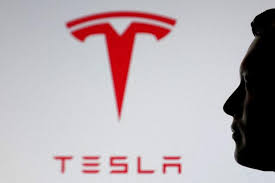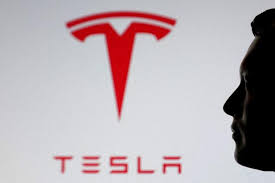
Tesla’s board has tied an unprecedented potential payout for CEO Elon Musk to a set of operational and market milestones that together imply an $8.5 trillion company — a leap from the firm’s current market value by an order of magnitude. The package, structured around a dozen performance gates over a decade, bundles product goals (vehicle deliveries, full-self-driving subscriptions, deployment of robotaxis and humanoid robots) with profitability targets that culminate in a top adjusted EBITDA threshold of roughly $400 billion. Hitting that profit target is the principal accounting route to the $8.5 trillion market capitalization baked into the package.
The plan is explicitly engineered to reframe Tesla away from a pure automaker valuation and toward a diversified AI, software and robotics enterprise. To do that, the company must both create large new revenue streams and convince equity markets to assign a still-elevated multiple to future cash flows — a combination of performance and investor optimism that underpins the arithmetic of the proposal. The board’s milestones therefore map product ambitions directly into profit and market-value objectives, making the path to $8.5 trillion a set of measurable checkpoints rather than a rhetorical aspiration.
Robotaxi revenue: scale, share and assumptions
A central pillar of the $8.5 trillion scenario is a robotaxi business far larger than today’s ride-hail incumbents. The company’s plan envisions a Tesla-owned and -operated robotaxi fleet that could capture a substantial portion of global ride-hailing revenue. In bullish models, annual ride-hail revenue for such a market runs into the hundreds of billions of dollars; some scenario analyses put potential gross market size near $1 trillion, with Tesla keeping a high share of fares because it owns the software, the hardware and the network.
Key assumptions drive the upside: Tesla must achieve reliable full self-driving at scale, remove the human safety monitor from commercial operations, and manage a fleet with far lower per-mile costs than human-driven cars. If a robotaxi network reaches millions of vehicles and Tesla captures a large fraction of fares, the recurring, high-margin nature of ride revenue could produce enormous EBITDA. But that outcome depends on regulatory acceptance, demonstrated safety, and consumer uptake — all of which add time and execution risk to the valuation thesis.
Beyond transportation, Tesla’s Optimus humanoid robot figures heavily in the company’s upside story. Analysts working through the pay package math note that Optimus must become a massive consumer and industrial product for Tesla to approach the upper EBITDA milestones. Using a working price assumption of roughly $25,000 per unit, selling tens of millions — or in extreme scenarios, more than 100 million — robots annually is the arithmetic path to hundreds of billions in EBITDA. At $25,000 apiece, 100 million units generate $2.5 trillion in revenue; a mid-teens EBITDA margin on that sales volume yields an EBITDA figure in the high hundreds of billions.
Proponents argue robots could be a utility-scale revenue engine — a hardware product that also embeds software, recurring services and AI subscriptions. Skeptics point to manufacturing scale, labor replacement friction, regulatory hurdles and real-world utility as steep barriers. Even under bullish assumptions that robots eventually command a dominant share of automation budgets across manufacturing and services, the ramp from prototype to mass adoption is unprecedented in speed and scale.
Valuation arithmetic: multiples, EBITDA targets and investor sentiment
Market value is a function of both expected profits and the multiple investors are willing to pay for those profits. Under current market sentiment, Tesla trades like a high-growth technology company, sometimes priced at many tens of times EBITDA or earnings — a premium justified by expectations of substantial future expansion. To reach $8.5 trillion at plausible multiples, analysts show that Tesla would need EBITDA in the low hundreds of billions even if markets trimmed today’s froth. The company’s board effectively baked that logic into the compensation plan by tying milestones to EBITDA thresholds as well as to market cap.
Investor psychology therefore matters as much as engineering. If Tesla proves the robotaxi and robot franchises are real and durable, investors could expand valuation multiples further; conversely, missed milestones or regulatory setbacks would push back both profit trajectories and the multiple. The $8.5 trillion target is thus the intersection of two large uncertainties: can Tesla generate extraordinary profits from new businesses, and will markets price those profits at elevated levels over the next decade?
Operational and regulatory hurdles
The operational mountain to scale robotaxis and robots is steep. Delivering reliable, generalizable full-self-driving requires sensor fusion, machine learning, fleet data, safety validation and significant software and hardware engineering. A commercial robotaxi fleet must also meet regulatory standards across multiple jurisdictions, gain insurance acceptance and survive intense public scrutiny after any high-profile incident. For robots, the manufacturing scale, costs of parts and the entire distribution and support infrastructure present further challenges.
Even if Tesla achieves technological breakthroughs, integrating these businesses into profitable, large-scale operations will be capital intensive. Factories, fleet management systems, charging and maintenance networks, customer service and regulatory compliance will all require sustained investment. Execution risk, supply-chain constraints and competition from established automotive and tech firms add to the uncertain road toward the payloads of revenue needed for the top EBITDA targets.
Analysts model a wide range of outcomes, from conservative scenarios in which robotaxis and Optimus add modest incremental value, to bull cases in which Tesla captures dominant shares of multiple trillion-dollar markets. In the bullish scenario, robotaxis deliver recurring high-margin revenue while robots create a vast hardware-plus-software market. Combined with existing vehicle and energy businesses, those new streams could produce the scale of cash flows that justify eye-watering market caps. In more muted views, Tesla remains a leader in electric vehicles and software but fails to generate the exponential new revenues required to approach $8.5 trillion.
Investor expectations are therefore being stretched: some funds model Tesla as an AI and robotics leader whose enterprise value will dwarf traditional automakers; others view the pay package as a speculative bet that crystallizes upside only under near-perfect execution and supportive market sentiment. The board’s decision to make the incentives public forces investors to weigh these scenarios explicitly.
Shareholder votes, regulatory milestones, early commercial robotaxi deployments and Optimus production roadmaps will serve as concrete checkpoints investors monitor. In the near term, milestones such as the commercialization of robotaxis at scale, meaningful recurring revenue from FSD subscriptions, production of prototype robots and sequential expansion of robot fleet sizes will be parsed for credibility. Each successful step could create a re-rating; each missed target could extinguish parts of the upside story.
In short, the path to $8.5 trillion is a composite of engineering breakthroughs, rapid manufacturing scale-up, regulatory approvals, and sustained investor willingness to price the future as if Tesla will dominate several multi-trillion-dollar markets. The board has translated that composite into a set of measurable goals — but turning the moonshot math into reality remains a task that tests both Musk’s ambitions and the capital markets’ appetite for believing in them.
(Source:www.reuters.com)
The plan is explicitly engineered to reframe Tesla away from a pure automaker valuation and toward a diversified AI, software and robotics enterprise. To do that, the company must both create large new revenue streams and convince equity markets to assign a still-elevated multiple to future cash flows — a combination of performance and investor optimism that underpins the arithmetic of the proposal. The board’s milestones therefore map product ambitions directly into profit and market-value objectives, making the path to $8.5 trillion a set of measurable checkpoints rather than a rhetorical aspiration.
Robotaxi revenue: scale, share and assumptions
A central pillar of the $8.5 trillion scenario is a robotaxi business far larger than today’s ride-hail incumbents. The company’s plan envisions a Tesla-owned and -operated robotaxi fleet that could capture a substantial portion of global ride-hailing revenue. In bullish models, annual ride-hail revenue for such a market runs into the hundreds of billions of dollars; some scenario analyses put potential gross market size near $1 trillion, with Tesla keeping a high share of fares because it owns the software, the hardware and the network.
Key assumptions drive the upside: Tesla must achieve reliable full self-driving at scale, remove the human safety monitor from commercial operations, and manage a fleet with far lower per-mile costs than human-driven cars. If a robotaxi network reaches millions of vehicles and Tesla captures a large fraction of fares, the recurring, high-margin nature of ride revenue could produce enormous EBITDA. But that outcome depends on regulatory acceptance, demonstrated safety, and consumer uptake — all of which add time and execution risk to the valuation thesis.
Beyond transportation, Tesla’s Optimus humanoid robot figures heavily in the company’s upside story. Analysts working through the pay package math note that Optimus must become a massive consumer and industrial product for Tesla to approach the upper EBITDA milestones. Using a working price assumption of roughly $25,000 per unit, selling tens of millions — or in extreme scenarios, more than 100 million — robots annually is the arithmetic path to hundreds of billions in EBITDA. At $25,000 apiece, 100 million units generate $2.5 trillion in revenue; a mid-teens EBITDA margin on that sales volume yields an EBITDA figure in the high hundreds of billions.
Proponents argue robots could be a utility-scale revenue engine — a hardware product that also embeds software, recurring services and AI subscriptions. Skeptics point to manufacturing scale, labor replacement friction, regulatory hurdles and real-world utility as steep barriers. Even under bullish assumptions that robots eventually command a dominant share of automation budgets across manufacturing and services, the ramp from prototype to mass adoption is unprecedented in speed and scale.
Valuation arithmetic: multiples, EBITDA targets and investor sentiment
Market value is a function of both expected profits and the multiple investors are willing to pay for those profits. Under current market sentiment, Tesla trades like a high-growth technology company, sometimes priced at many tens of times EBITDA or earnings — a premium justified by expectations of substantial future expansion. To reach $8.5 trillion at plausible multiples, analysts show that Tesla would need EBITDA in the low hundreds of billions even if markets trimmed today’s froth. The company’s board effectively baked that logic into the compensation plan by tying milestones to EBITDA thresholds as well as to market cap.
Investor psychology therefore matters as much as engineering. If Tesla proves the robotaxi and robot franchises are real and durable, investors could expand valuation multiples further; conversely, missed milestones or regulatory setbacks would push back both profit trajectories and the multiple. The $8.5 trillion target is thus the intersection of two large uncertainties: can Tesla generate extraordinary profits from new businesses, and will markets price those profits at elevated levels over the next decade?
Operational and regulatory hurdles
The operational mountain to scale robotaxis and robots is steep. Delivering reliable, generalizable full-self-driving requires sensor fusion, machine learning, fleet data, safety validation and significant software and hardware engineering. A commercial robotaxi fleet must also meet regulatory standards across multiple jurisdictions, gain insurance acceptance and survive intense public scrutiny after any high-profile incident. For robots, the manufacturing scale, costs of parts and the entire distribution and support infrastructure present further challenges.
Even if Tesla achieves technological breakthroughs, integrating these businesses into profitable, large-scale operations will be capital intensive. Factories, fleet management systems, charging and maintenance networks, customer service and regulatory compliance will all require sustained investment. Execution risk, supply-chain constraints and competition from established automotive and tech firms add to the uncertain road toward the payloads of revenue needed for the top EBITDA targets.
Analysts model a wide range of outcomes, from conservative scenarios in which robotaxis and Optimus add modest incremental value, to bull cases in which Tesla captures dominant shares of multiple trillion-dollar markets. In the bullish scenario, robotaxis deliver recurring high-margin revenue while robots create a vast hardware-plus-software market. Combined with existing vehicle and energy businesses, those new streams could produce the scale of cash flows that justify eye-watering market caps. In more muted views, Tesla remains a leader in electric vehicles and software but fails to generate the exponential new revenues required to approach $8.5 trillion.
Investor expectations are therefore being stretched: some funds model Tesla as an AI and robotics leader whose enterprise value will dwarf traditional automakers; others view the pay package as a speculative bet that crystallizes upside only under near-perfect execution and supportive market sentiment. The board’s decision to make the incentives public forces investors to weigh these scenarios explicitly.
Shareholder votes, regulatory milestones, early commercial robotaxi deployments and Optimus production roadmaps will serve as concrete checkpoints investors monitor. In the near term, milestones such as the commercialization of robotaxis at scale, meaningful recurring revenue from FSD subscriptions, production of prototype robots and sequential expansion of robot fleet sizes will be parsed for credibility. Each successful step could create a re-rating; each missed target could extinguish parts of the upside story.
In short, the path to $8.5 trillion is a composite of engineering breakthroughs, rapid manufacturing scale-up, regulatory approvals, and sustained investor willingness to price the future as if Tesla will dominate several multi-trillion-dollar markets. The board has translated that composite into a set of measurable goals — but turning the moonshot math into reality remains a task that tests both Musk’s ambitions and the capital markets’ appetite for believing in them.
(Source:www.reuters.com)





